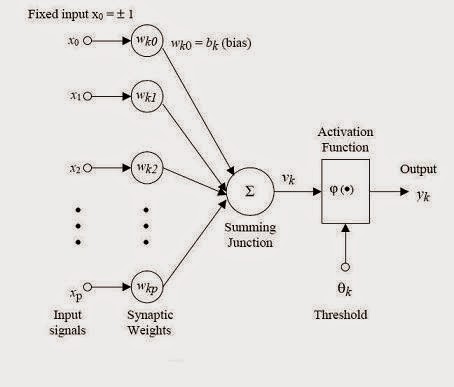Introduction:
Artificial Neural Networks(ANN) are biologicially inspired computational modals which mimics Animal Central nervous system.Researchers from many fields are developing Artificial Neural Network to solve many Engineering Problems like Pattern Recognition, Optimization, Control,etc.
Biological Inspired Artificial Neural Networks are massively parallel systems computing model consists of an extremely large number of processing units called nodes which are wired together in a complex communication network. Each unit/nodes is a simplified model of a real neuron which fires (which means sends electrical impulse from one neuron to other) and also get fired.
Biological Neuron
Artificial Neuron
Dendrites ------- input
soma ------- Processing unit
Axon ------- Output
Advantage:
- Non-Linearity: Interconnection of non linear neurons which means we can design Neural Network for non linear Function. Non-linearity is Distributed throughout the Networks.
- Input-Output Mapping
- Adaptivity: It can adapt to the free parameters to changes in the surrounding environment.
- Evidential Response: Decision with a measure of "Confidence"
- VLSI implemetation
- Massively Parallel
- Fault Tolerance and
- Learning Ability
- Prediction: For a given set of n input function "f" to a sequence of respective independent varibles of the function . The task is to predict the future at n+1. It can be done easily with high tolerance in Neural Network.
- Optimization: Many of the Problems in Engineering, Scientific, Mathematics,Economics,etc. can be converted into Optimization Problems.The goal of the optimization problem is to maximize or minimize the Objective function for the constrained or unconstrained independent varaiables. One of the classical Example is Traveling Salesman Problem(TSP).
- Function Approximation: Suppose we have training samples input and output for a function f subjected to noise .We can estimate f' from the training samples which can produce most approximated output with less noise than the function f.
- Pattern classification:
- Categorization/Clustering :
- Robotics: Manipulators and trajectory control, Machine vision system,etc..,
- Electronics: Voice Synthesis, nonlinear modeling, chip failure analysis.,
- Defence: Signal/image identification, object discrimination, facial recognition, target tracking,etc..,
- Manufacturing: Manufacturing process control, analysis of grinding operation, tool wear prediction,planning and management, dynamic modeling of chemical process systems, real-time particle identification, visual quality inspection
- Medical: Breast cancer cell analysis, hospital quality improvement, emergency room test advertisement
- Telecommunication: Image and data compression, customer payment processing
- Aerospace: Aircraft components fault detection, autopilot enhancement, aircraft component simulation,flight path simulation
- Automotive: Automobile guidance system, fault analysis system


No comments:
Post a Comment